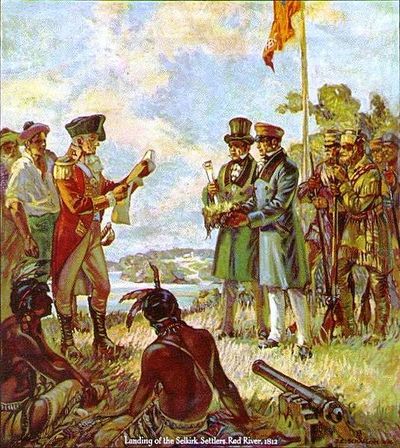- From the Red River Settlement to Manitoba (1812—70)
- Maps
- The Earl of Selkirk: The Colony’s Founder
- An Arduous Task, Marked by a Private War (1812—21)
- The Métis
- Indigenous Peoples
- Colonial Administration
- Maintaining Order and the Colony’s Defence
- Of Fur and Wheat: Subsistence and the Economy
- From Canoes to Railways: Transportation
- Life in Red River
- Missions and Religious Life
- Education, Health, and Social Assistance
- Arts and Culture
- The Press
- Intellectual and Scientific Life
- Winnipeg: The Emergence of an Urban Core
- Debating the Status of the Colony (1850—70)
- The Red River Rebellion and the Creation of Manitoba, 1869—70
- Suggested Readings on the Métis
The Earl of Selkirk: The Colony’s Founder

Source: Courtesy of Wikimedia Commons
“The Red River colony, if not absolutely ill-conceived, as the Nor’Westers asserted, was born under an unlucky star. For ten years it was to be the focus of the mounting struggle between the two great fur-trading companies, a struggle that cost many lives, ruined the NWC, destroyed Selkirk’s great fortune, and contributed to his early death.”
Established in turmoil, the colony of Red River owes its existence to Thomas DOUGLAS, 5th Earl of Selkirk, who devoted to it a significant part of his life and his wealth. This Scotsman had two objectives when he set up the colonies on Prince Edward Island (1803), in Upper Canada (1804), and at Red River (1812):
“[Douglas’s] education [at the University of Edinburgh] was filled out in 1792 with some months of travel in the Highlands of Scotland, an experience which was to influence the course of his life decisively.…
“Douglas never lost interest in the Highlands after his travels there, and he studied Highland affairs and learned some Gaelic. He had been shocked by the effect of the clearances with their callous, if inevitable, uprooting of helpless people who obviously were capable and deserving of a better life. Though he had not been in a position to help he had begun to develop a theory of emigration that might both restore hope to dispossessed people and strengthen Britain overseas.”
As early as 1802 Selkirk was interested in the Red River area, then part of the extensive landholdings of the Hudson’s Bay Company (HBC). With two partners, he started buying shares in the company in 1808 to increase the chances of success for his project, which raised some concerns for the North West Company (NWC), the HBC’s main competitor:
“The idea of the company’s developing an agricultural settlement at Red River as a refuge for retired fur traders and a source of food that had otherwise to be brought from England had already been discussed by the [HBC’s governing] committee and had some support. It was against this background that Selkirk early in 1811 put forward his plan, which called for a large grant of land anchored to a substantial settlement. When news of the proposal reached the NWC the partners did not take the settlement idea very seriously but considered that if it should succeed it might destroy their trade, for the site was astride their route to Athabasca and they were already in financial difficulty through loss of markets and rising costs.… Too late the NWC attempted to block the grant. In June 1811 agreements were signed by Selkirk and the HBC under which, in return for founding an agricultural settlement and some other considerations, he was to have some 116,000 square miles – an area five times the size of Scotland and much of it magnificent land – for 10 shillings. Lady Selkirk would later call it, with playful bitterness, his Kingdom of Red River.”
To learn more about Selkirk, the reasons for his interest in the Red River area, and his previous colonial initiatives, consult the following biographies.





